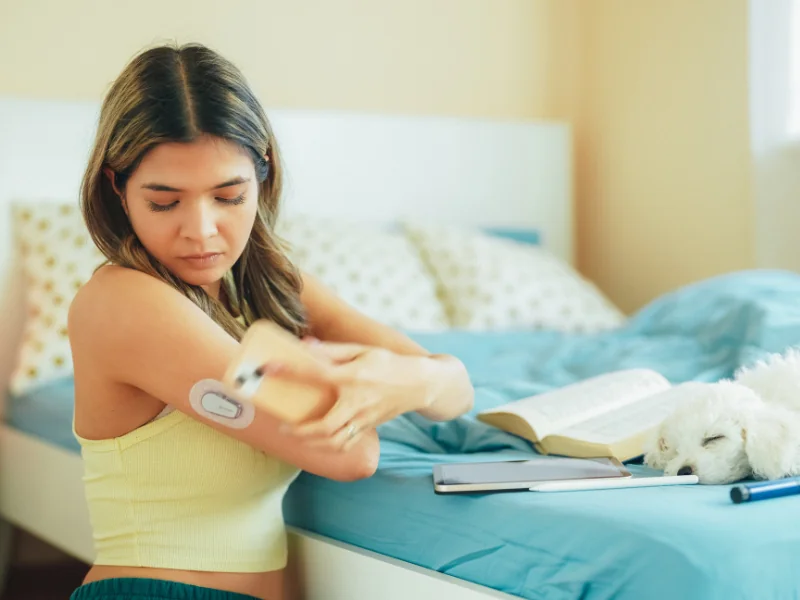Personalizing Insulin Therapy: Tailoring Your Diabetes Treatment for Optimal Glucose Control

When it comes to medications to treat diabetes and maintain goal glucose levels, insulin is truly king (or queen). It is the only medication that we can continue to scale up to the needs of each individual. In the first article of this series, we talked about the two types of insulin, basal and bolus, and how they were used to mimic the natural insulin release that occurs in the body. In this article, we are going to take the next step and talk about how insulin therapy can be more individualized and some of the special considerations we need to be aware of when using insulin.
To review, in insulin therapy the basal or intermediate/long-acting insulins are those which mimic the small trickle of insulin that the body releases over the course of the day to keep everything running. The bolus or short/rapid-acting insulins are those that help bring the glucose excursion after meals back down to normal levels. When your doctor or diabetes specialist is working to manage your insulin regimen, they use your glucose levels to help assess if more or less insulin is needed. To assess the basal insulin the fasting glucose levels are the primary data that is used. So, if the fasting glucose level is above goal (ADA goal of <130 mg/dL or AACE goal of <110 mg/dL) then an increase is needed to the basal insulin, or if there are significant numbers of low glucose levels or even hypoglycemic events than the basal insulin is decreased. These adjustments are not done with one glucose reading. Typically, when regimens are being adjusted your diabetes provider will look at 3-5 days (or more) worth of glucose readings before determining what to do. Typically, the initial focus is on the basal level to get it to goal and then the focus will shift to the bolus dosing. When looking to see if bolus insulin therapy is adjusted correctly 2-hour post-meal glucose levels are used. The two hour post-meal glucose level goal for ADA is <180 mg/dl and for AACE is <140mg/dL. So, if 2 hours after lunch the blood glucose is typically higher than your goal one of two things has to happen, you eat less lunch or you give more bolus insulin. Again, this is not based on one glucose level, but by looking at the trend over multiple days. And it isn’t just one meal that needs to be looked at, but all three. But who eats the same thing at each meal every day? Because of this bolus insulin therapy can be a little trickier to manage. There is a way of making bolus insulin therapy more individualized and allowing for a greater ability to match insulin to the meal that is being consumed… insulin to carbohydrate ratio.
Let’s talk about insulin-to-carbohydrate (or carb for short) ratios and how this can play into bolus insulin therapy. I don’t know about you, but my diet is not static. I may have a lunch one day that consists of grilled chicken salad, pretty low on the carbohydrate scale, and the next have a never-ending pasta meal which could blow the top out of the carbohydrate scale. Remember carbohydrates are the main nutrient that turns into glucose, so the higher the carbohydrate content of the meal the higher the glucose level after the meal the more bolus insulin is needed. This is where the insulin-to-carb ratio can be extremely useful. Basically, what the insulin-to-carb ratio represents is the amount of carbohydrate that is covered by one unit of insulin. So, if you have an insulin-to-carb ratio of 1 to 15 (1:15) then 1 unit of insulin will cover 15 grams of carbohydrate consumed. For example, if you had that grilled chicken salad with a small roll for a total of 30 grams of carbohydrate you would need 2 units of bolus insulin to cover that meal and bring you back to goal 2 hours post-meal. Versus the never-ending pasta bowl that has 120 grams of carbohydrate where you would need 8 units of insulin to cover the meal. If you were on a typical set dose regimen of bolus, say 5 units at each meal, your 2-hour post-meal glucose might be too low on the grilled chicken salad day and too high on the never-ending pasta day. So, you can see where using the insulin-to-carb ratio could be greatly beneficial to meeting glucose goals, but it takes a little extra effort. First, your individualized insulin-to-carb ratio would have to be determined. There is a quick equation that helps to establish a starting point. It is the 500 Rule. Basically, you divide 500 by your total daily dose of insulin. As an example, if the basal insulin dose was 40 units and the bolus insulin was 5 units with each meal the total daily dose of insulin would be 55 units, 500 ÷ 55 = 9, so 1 unit of insulin would cover 9 grams of carbohydrate or 1:9 insulin to carb ratio. This is not a fixed number, just a starting point, and will need to be adjusted as it is used in “the real world.” The second part of using the insulin-to-carb ratio for your bolus insulin needs is knowing how to count the carbohydrates in your food. This takes understanding what foods contain carbohydrates, being able to determine (or at least closely guess) serving sizes to know the amount of carbohydrate, and then putting your math skills into practice. There are wonderful tools available to help with determining carbohydrates, package food labels or food guides for restaurants (typically on their websites). Smartphone apps like Calorie King or My Fitness Pal (two of my patients’ personal favorites) will also have food labels and guides available for reference. The ADA also has great carbohydrate counting booklets that can help with the learning process.
If you want your bolus insulin therapy to become even more individualized, you can find your correction factor which can be plugged into an equation that will calculate how much bolus insulin you would need to bring your glucose levels back to goal. An example of how this would be used if you took your glucose level before lunch and it was 200mg/dL and your goal before eating is 120mg/dL your level is 80mg/dL over goal and then your are going to eat lunch and the bolus insulin you are giving using the insulin to carb ratio only will cover the carbohydrate excursion from the food you are going to eat. You need a “correction dose” of insulin to take care of the 80mg/dL over goal. The correction factor is our starting point to get to this correction dose, and there is another “rule” to get the starting correction factor. The 1800 Rule (or some settings use 1500) is this starting point. By dividing 1800 by the total daily dose this gives an estimate of how much 1 unit of insulin will lower the glucose. Using the example from above with total daily dose of 55 units, 1800 ÷ 55 = 32, meaning that 1 unit of insulin should lower glucose approximately 32 points. This correction factor is then plugged into the correction dose equation which is:
(Current glucose – goal glucose) ÷ correction factor = correction insulin dose
Using our example of glucose prior to a meal of 200 mg/dL and goal glucose of 120 mg/dL and correction factor of 32 our correction dose equation would be:
(200-120) ÷ 32 = 2.5 units of insulin
We typically do not give half units of insulin so you would have to decide if you would give 2 or 3 units to correct the glucose. Since this is done typically prior to a meal this correction dose could be added to, not in place of, the meal-time insulin dose.
This all may seem complicated, and it can be, but if you currently are using basal/bolus insulin regimen and are interested in making it more personalized you could ask your physician or diabetes educator if this would be appropriate to try. If you use an insulin pump you are probably already familiar with both insulin to carb ratios and correction dosing, and your pump might do the math for you! But just remember that the rules that we use to get started are simply good estimations of what you might need, monitoring your glucose levels and having your doctor of diabetes educator evaluate the results is what will be needed to refine both your insulin to carb ratio and correction factor. But it can be worth the effort to help get your insulin therapy personalized for your lifestyle and glucose levels at goal.
View References
1: Diabetes Care 2024; 47(Suppl.1):SS1-S309 / https://doi.org/10.2337/cd24-S005
2: Canagliflozin [package insert]. Titusville, NJ: Janssen Pharmaceuticals, Inc.; 2022.
3: Dapagliflozin [ package insert]. Wilmington, DE: AstraZeneca Pharmaceuticals LP; 2022.
4: Empagliflozin [package insert]. Ridgefield, CT: Boehringer Ingelheim Pharmaceuticals, Inc.; 2022.
5: Dulaglutide [package insert]. Indianapolis, IN: Eli Lilly Pharmaceuticals, Inc.; 2022.
6: Exenatide [package insert]. Indianapolis, IN: Eli Lilly Pharmaceuticals, Inc.; 2022.
7: Liraglutide [package insert]. Plainboro, NJ: Novo Nordisk, Inc.; 2022.
8: Lixisenatide [package insert]. Bridgewater, NJ: Sanofi-Aventis U.S. LLC.; 2022.
9: Semaglutide [package insert]. Plainboro, NJ: Novo Nordisk, Inc.; 2022.
10: Tirzepatide [package insert]. Indianapolis, IN: Eli Lilly Pharmaceuticals, Inc.; 2022
11: https://www.drugs.com/metformin.html
12: https://www.drugs.com/sulfonylurea.html
13: Sitagliptin [package insert]. Rahway, NJ: Merck Pharmaceuticals, Inc; 2023
14: https://www.drugs.com/onglyza.html
15: Linagliptin [package insert]. Ridgefield, CT: Boehringer Ingelheim Pharmaceuticals, Inc; 2023
16: https://www.drugs.com/pioglitizone.html
17: https://www.drugs.com/drug-class/insulin.html
18. https://www.mayoclinic.org/diseases-conditions/high-blood-cholesterol/in-depth
19: https://www.mayoclinic.org/healthy-lifestyle/weight-loss/in-depth
20: https://www.drugs.com/glucagon.html
21: Gvoke [package insert]. Chicago, IL: Xeris Pharmaceuticals. 2023
22: Baqsimi [package insert]. Rancho Cucamonga, CA Amphastar Pharmaceuticals. 2019
Written by






